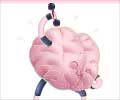According to a new study people who have gone partially blind after suffering a stroke can regain some vision by doing a set of vigorous visual exercises on a computer every day for several months.
According to a new study people who have gone partially blind after suffering a stroke can regain some vision by doing a set of vigorous visual exercises on a computer every day for several months.
Dr. Krystel Huxlin, a neuroscientist and associate professor who led the study of seven patients at the University of Rochester Eye Institute, has developed a computer system that exercises the brain, forcing it to develop to compensate for the damage caused by stroke."We were very surprised when we saw the results from our first patients. This is a type of brain damage that clinicians and scientists have long believed you simply can't recover from. It's devastating, and patients are usually sent home to somehow deal with it the best they can," said Huxlin.
He added that the results have come as a ray of hope for patients with vision damage from stroke or other causes.
In the study, Huxlin studied seven people who had suffered a stroke that damaged an area of the brain known as the primary visual cortex or V1, which serves as the gateway to the rest of the brain for all the visual information that comes through our eyes.
V1 passes visual information along to dozens of other brain areas, which process and make sense of the information, ultimately allowing us to see.
Patients with damage to the primary visual cortex have severely impaired vision, they typically have a difficult or impossible time reading, driving, or getting out to do ordinary chores like grocery shopping.
Advertisement
The researchers sought to build on this "blindsight", visual information, of which the patient is unaware, that still reaches the brain.
Advertisement
The team focused on motion perception, since it's an aspect of vision critical for most everyday tasks.
The researchers wanted to see whether the brain's middle temporal region, which was healthy in the participants, could be stimulated so extensively that it could take on some of the tasks normally handled by the visual cortex.
For the experiment, participants fixed their gaze on a small black square in the middle of a computer screen, and the scientists used a sensitive eye tracker to make sure patients keep staring at the square.
Every few seconds, a group of about 100 small dots appears within a circle on the screen, somewhere in the person's damaged visual field, in other words, when the patients stare at the square, they don't initially see the dots.
The dots twinkle into existence, appear to move as a group either to the left or the right, then disappear after about one-half second. Then the patient has to choose whether the dots are moving left or right.
A chime indicates whether he or she chose correctly, providing feedback that lets the brain know whether it made the right choice and speeding up learning.
The five participants who performed the training and completed the experiment had significantly improved vision. They were able to see in ways they weren't able to before the experiment began.
A few found the experiment life-changing, a couple of participants are driving again, for instance, or have gained the confidence to go shopping and exercise frequently.
"Basically, it's exercising the visual part of the brain every day. It's very hard work, very grueling. By forcing patients to choose, you're helping the brain re-develop," said Huxlin.
The study has been published in the Journal of Neuroscience.
Source-ANI
ARU/L













